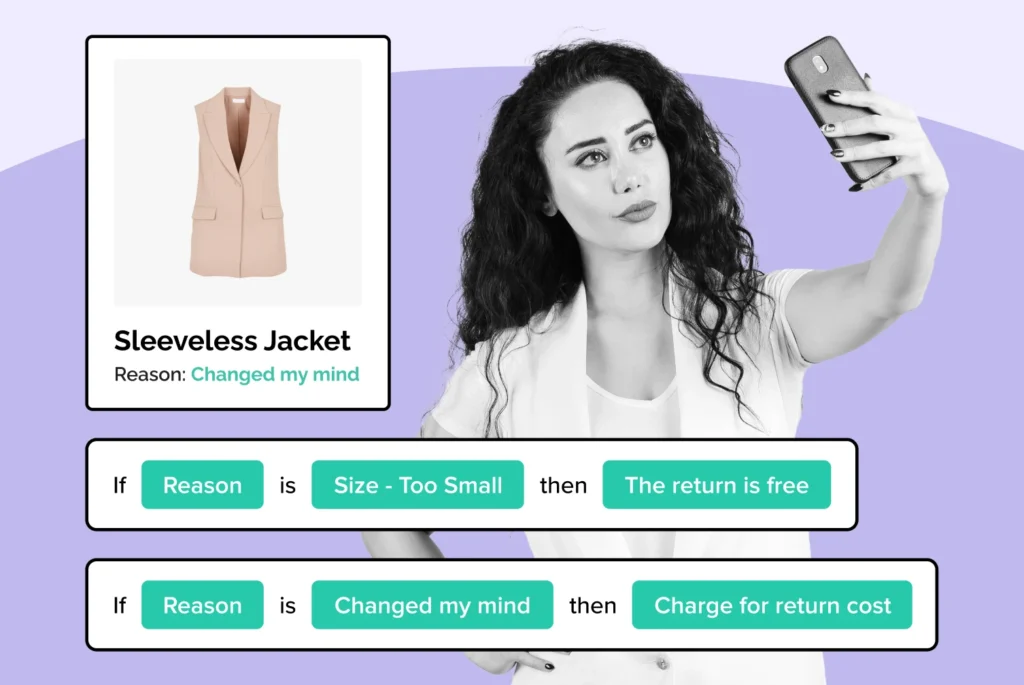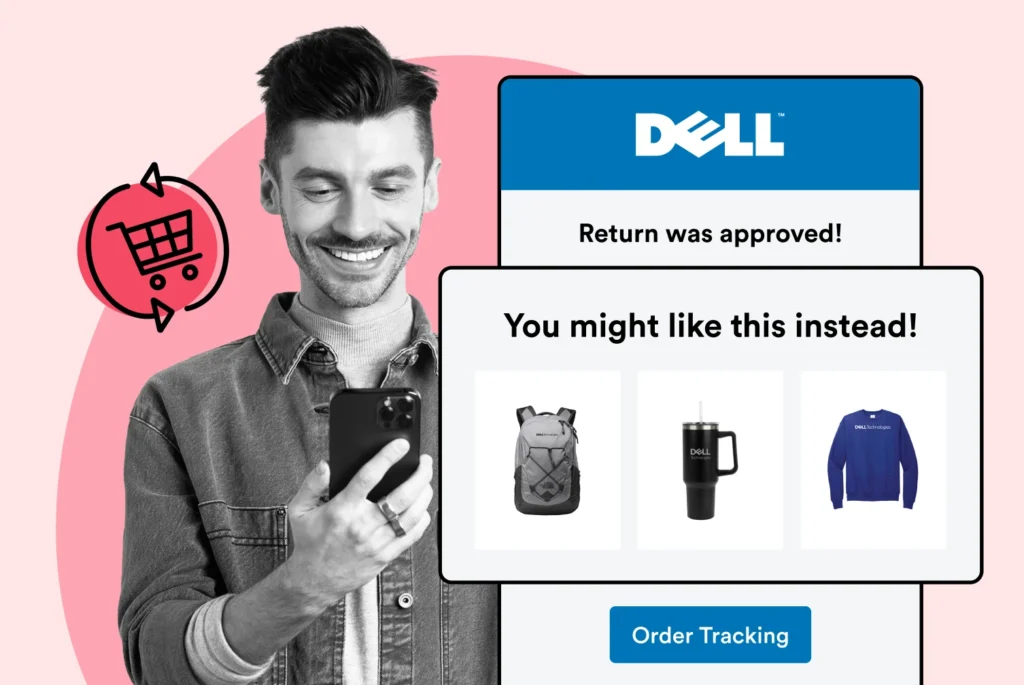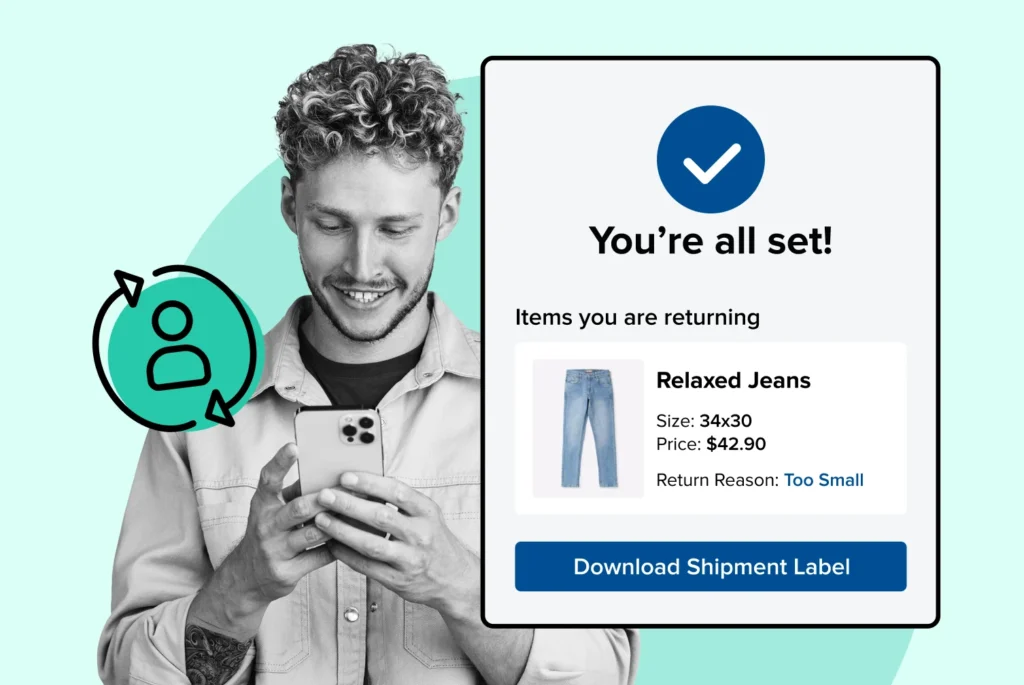
Mastering International Shipping: Cross Border Returns Simplified
Learn how to turn cross-border complexities into opportunities for your business without getting lost in the process!
Shipping, Tracking & Notifications
Boost customer experience and reduce support tickets
Realtime order and shipment tracking
Proactive order and shipping notifications
AI-Enhanced Discounted Labels
Predictive pre-purchase estimated delivery dates
Self-Serivce branded order tracking
Effortless experience delivered
Identify and Resolve Order Issues
Realtime order and shipment tracking
Make returns profitable and delight customers
Flexibility to define any return destinations & conditions
Simplify returns for your customers and team
Incentivize exchanges over returns
Returns management made easy for your team
Returns management made easy for your team
Easy claims and smart upsells
Understand why your customers are returning
In-Store & Curbside Pickup
Unify the online and the in-store experience
Hassle-free pickup experience for customers
In-Store dashboard to keep operations streamlined
In-Store and Online orders unified
Drive foot-traffic to your stores
Shipping, Tracking & Notifications
Boost customer experience and reduce support tickets
Realtime order and shipment tracking
Proactive order and shipping notifications
AI-Enhanced Discounted Labels
Predictive pre-purchase estimated delivery dates
Self-Serivce branded order tracking
Effortless experience delivered
Identify and Resolve Order Issues
Realtime order and shipment tracking
Make returns profitable and delight customers
Flexibility to define any return destinations & conditions
Simplify returns for your customers and team
Incentivize exchanges over returns
Returns management made easy for your team
Returns management made easy for your team
Understand why your customers are returning
In-Store & Curbside Pickup
Unify the online and the in-store experience
Hassle-free pickup experience for customers
In-Store Dashboard to keep operations streamlined
In-Store and Online orders unified
Drive foot-traffic to your stores
Boost customer experience and reduce support tickets
Realtime order and shipment tracking
Proactive order and shipping notifications
AI-Enhanced Discounted Labels
Predictive pre-purchase estimated delivery dates
Self-Serivce branded order tracking
Effortless experience delivered
Make returns profitable and delight customers
Flexibility to define any return destinations & conditions
Simplify returns for your customers and team
Incentivize exchanges over returns
Returns management made easy for your team
Equip your team for precise return checks.
Easy claims and smart upsells
Understand why your customers are returning
Unify the online and the in-store experience
Hassle-free pickup experience for customers
In-Store Dashboard to keep operations streamlined
In-Store and Online orders unified
Drive foot-traffic to your stores
Find the answer to all your questions
Take a step by step trip through our functionality to see how we can improve your ecommerce processes.
Explore the most comon questions about WeSupply
Calculate the ROI that WeSupply can bring you
Read actionable articles on how to optimize your post-purchase experience and decrease support tickets
Get inspired by stories of how our customers implemented an effortless post-purchase experience
Wondering if WeSupply is a good fit for you? Read through our use cases to see how we can help you increase conversion & improve CX!
A Deep Dive into Top Companies' Order Tracking & Returns Strategy
Find the answer to all your questions
Explore the most comon questions about WeSupply
Calculate the ROI that WeSupply can bring you
Request a no strings attached review of your current shopping experience and missed conversion opportunities
Take a step by step trip through our functionality to see how we can improve your ecommerce processes.
Read actionable articles on how to optimize your post-purchase experience and decrease support tickets
Get inspired by stories of how our customers implemented an effortless post-purchase experience
A Deep Dive into Top Companies' Order Tracking & Returns Strategy
Wondering if WeSupply is a good fit for you? Read through our use cases to see how we can help you increase conversion & improve CX!

Are you grappling with ecommerce returns? Learning how to manage ecommerce returns with operational excellence is essential for business success. This article cuts through the clutter to show you how to streamline your returns process, utilizing best practices that reduce costs, improve customer loyalty, and protect your bottom line. Ready to turn your returns process into a competitive asset? Let’s dive in.
Effective returns management is crucial for customer retention and operational efficiency in ecommerce, with online return rates averaging between 20-30% compared to 5% for in-store purchases.
Implementing customer-centric return policies and leveraging technology like automation, AI, and self-service options can streamline the returns process and reduce costs for businesses.
Minimizing returns through proactive measures, such as understanding customer behavior and encouraging eco-friendly practices, can enhance customer trust and mitigate the environmental impact of ecommerce operations.
WeSupply helps eCommerce businesses optimize returns management with data-driven insights, automated processes, and eco-friendly practices. Key features include SKU-level analytics, pre-built return policies, intelligent dispositions, and integrations with major carriers. These solutions streamline operations, reduce costs, and enhance customer satisfaction. Proactive email and SMS notifications, personalized offers, and customer surveys further refine the post-purchase experience. Get Started with WeSupply to elevate your eCommerce returns management.
In the bustling ecommerce market, managing returns is more than a mere operational task; it’s a pivotal factor that can sway the competitive e-commerce landscape. Ecommerce businesses that master the art of return management not only strengthen customer loyalty but also pave the way for a robust future in selling online.
With the ecommerce business model inherently leading to higher return rates, effective returns management becomes indispensable for maintaining customer satisfaction and ensuring business efficiency.
The ecommerce boom has revolutionized shopping, offering unparalleled convenience but also leading to a surge in returns, with as much as 16.5% of merchandise bought online returned. In the fashion-forward markets of India, the return order volume reached a staggering 15.8%, particularly from the apparel and footwear categories. This trend underscores the need for a robust reverse logistics system, as managing returns effectively is critical for customer retention and mitigating the financial burden associated with return shipping,.
Indeed, with ecommerce businesses facing an average return rate between 20-30%, the entire returns process has become a vital component in the competitive e-commerce landscape.
Efficient returns management is the linchpin of operational excellence, ensuring that the return management process enhances customer loyalty and fosters business efficiency. By investing in returns management software and the entire returns process, from user-friendly interfaces to automated return authorization, businesses can streamline returns management, reducing the time and costs associated with handling returns.
Moreover, a well-oiled returns management system offers the following benefits:
Aid in the physical handling of products
Provide valuable insights into customer behavior
Aid in long-term success
Prevent fraudulent returns
The realm of ecommerce is unique; it operates under different rules than brick-and-mortar stores, especially when it comes to returns. High return rates have a pronounced impact on ecommerce businesses, affecting everything from customer retention to inventory management.
In the digital age, understanding the intricacies of manage returns is crucial for sustaining a successful ecommerce business in the competitive e-commerce landscape. Let’s delve into the nuances that differentiate online returns from their physical counterparts, and explore the factors that contribute to the high return rates in e-commerce platforms.
The disparity between online and in-store return rates is stark; online transactions average a 15.2% return rate, a stark contrast to the 5% for in-store purchases. This discrepancy is even more pronounced in sectors like discount department stores, where the online return rate is over five times higher than in-store.
The reasons for returns in e-commerce are diverse, including:
Damaged items
Wrong size or color
Dissatisfaction with the product
Changed mind
Item not as described
Late delivery
Unwanted gifts
Practice of ‘bracketing’—buying multiple items with the intention of returning some
This comparison highlights the need for ecommerce businesses to encourage repeat business by implementing effective returns management strategies that cater to the unique challenges of selling online.
A multitude of factors contribute to the elevated return rates in the ecommerce business. Return policies play a critical role in customer decision-making, with 82% considering them before making a purchase. Tactics like ‘keep it’ policies, where customers are refunded yet retain the product, have emerged to mitigate the costs associated with managing returns.
The reasons for returns are varied, from items not fitting expectations to buyer’s remorse, which accounts for 11% of online returns. Understanding these factors is essential for ecommerce businesses to manage returns effectively and maintain stronger customer relationships in the long term.
WeSupply can help eCommerce businesses understand the impact of returns through comprehensive returns analytics. By leveraging data-driven insights, businesses can improve product offerings, streamline processes, and enhance profit margins. Key features include:
Understanding and acting on these insights can lead to more informed decision-making regarding return policies, product mixes, and overall customer satisfaction.
Returns Analytics for eCommerce Business
Understand why your customers are returning: Identify the most returned products, Understand why those products are returned, Identify which customers are serial returners, Reduce Return Rate with Actionable Insights, Returns data available in BigQuery.
In a world where customer satisfaction is paramount, efficient handling of returns is a critical factor in fostering customer trust and loyalty. From addressing product misrepresentation to mitigating the effects of buyer’s remorse, ecommerce businesses must navigate a plethora of challenges to ensure a positive customer experience.
Let’s examine the common reasons for returns and how ecommerce businesses can enhance their operational efficiency to minimize customer frustration and build long-lasting relationships.
The gap between customer expectations set by high quality images online and the reality of the product received is a primary driver of customer dissatisfaction. To combat this, ecommerce businesses must ensure accuracy in their advertising and provide comprehensive product descriptions.
The phenomenon of customers ordering multiple variations to return the undesired options, exacerbated by free return policies, further inflates return rates.
It’s essential for businesses to:
Maintain inventory visibility
Ensure product quality
Deter customers from exploiting return policies
Keep the commerce businesses thriving.
WeSupply helps eCommerce businesses address product misrepresentation by analyzing SKU level returns. This enables businesses to quickly identify return reasons and make necessary adjustments to improve customer satisfaction. Key features include:
By leveraging these insights, businesses can ensure product images match reality, reducing returns and enhancing customer trust.
Damaged or defective products rank among the top reasons for customer dissatisfaction and returns. Efficient handling of these issues is crucial to maintaining customer trust and loyalty. Businesses must ensure that they have responsive customer support and effective quality control processes in place to address these concerns swiftly and preserve customer relationships.
WeSupply’s pre-built return policies help eCommerce businesses effectively manage damaged or defective products, ensuring a smooth customer experience and maintaining trust. Key features include:
Waive Return Fees for Damaged Products: Automatically waive return and restocking fees for damaged items, simplifying the process and aligning with customer expectations.
These policies improve customer satisfaction, encourage repeat business, and enhance overall profitability by reducing the volume of returns.
The ecommerce market is ever-changing, and adapting to shifts in consumer preferences is key to customer satisfaction and retention. Trends such as bracketing, where customers buy multiple items with the intent to return some, reflect uncertainties in product fit or description,. By investing in returns processing technology and creating user-friendly online returns portals, retailers can keep pace with consumer trends and maintain strong customer relationships.
WeSupply helps retailers adapt to changing consumer preferences with innovative solutions. Key features include:
Intelligent Dispositions: Optimize efficiency and sustainability.
Return Analytics: Identify trends and refine product offerings.
These solutions enable retailers to effectively respond to consumer preferences, enhancing customer satisfaction and boosting sales.
Operational efficiency is the cornerstone of successful returns management in business operations. Businesses must seek to reduce processing costs, manage inventory effectively, and maintain a positive impact on customer satisfaction and trust.
With a focus on the entire returns process, from shipping and inspection to the final disposition of returned items, let’s explore the entire process and the strategies that can lead to reduced operational costs and stronger customer relationships.
The cost of processing returns can be staggering, with expenses including shipping, inspection, and refunds all contributing to high associated costs. Businesses may absorb up to 66% of the original item’s price when managing returns, even if the merchandise is returned in sellable condition.
Automation and streamlining the reverse logistics process can reduce these costs and minimize the impact on the business’s bottom line.
WeSupply helps retailers manage high processing costs associated with shipping, inspection, and refunds through automated returns management and pre-built return policies. Key features include:
Speed up the returns process
Streamline operations
Minimize RMA costs
Improve inventory management with better inspections and restocks
Charge shipping fees based on return reason, balancing cost management with customer service
Apply restocking fees for specific products to mitigate return costs and maintain profitability
These solutions help reduce financial strain, improve efficiency, and enhance overall customer satisfaction. By optimizing these processes, WeSupply can significantly boost your ROI, ensuring a more profitable and sustainable business model. Ready to see the impact on your bottom line? Try our ROI Calculator now!
Managing returned inventory presents logistical and restocking challenges for ecommerce businesses. Efficiently determining the disposition of returned items is key to alleviating these challenges.
By doing so, returned items become available for new purchases more quickly, positively influencing company revenue.
WeSupply helps retailers manage logistics and restocking issues associated with returned inventory through efficient inspection processes and intelligent disposition systems. Key features include:
Inspect Returns and Manage Inventory Better:
Implement strict quality control criteria
Collect images and feedback from customers
Enable warehouse staff to leave inspection notes
Route products to appropriate locations based on type, origin, and warehouse capabilities
Direct heavy items to equipped facilities, and lighter items to nearby locations
Send items to recycling centers, donation facilities, or outlet stores when needed
These solutions streamline the returns process, save time and money, reduce environmental impact, and enhance customer satisfaction.
WeSupply offers a specialized returns management platform designed to enhance customer satisfaction and streamline the returns process for businesses. Key features include:
Self-Service Returns Process: Allow shoppers to manage their returns independently, meeting the demand for a frictionless eCommerce experience.
Flexible Returns Rules: Create customizable return policies that adapt to various scenarios, ensuring a hassle-free process.
Autogenerated QR Code Return Labels: Simplify returns with QR codes sent via email, eliminating the need for customers to print labels.
Returns Tracking: Enable customers to track the status of their returns effortlessly, providing peace of mind and transparency.
Post-Purchase Notifications: Utilize high open-rate email and SMS notifications to send return shipping updates and personalized offers, encouraging repeat business.
Creating a customer-centric returns policy is essential for ecommerce businesses seeking to encourage repeat business and manage returns effectively. A comprehensive policy not only increases customer loyalty but also opens new profit opportunities. By outlining acceptable reasons for returns and any associated fees clearly, businesses can set the stage for stronger customer relationships.
Clarity and transparency in return policies are key to building customer trust and managing returns efficiently. By clearly articulating the policy duration, coverage, liabilities, and process, businesses can guide customers and potentially reduce returns.
A well-communicated policy can also help reduce chargebacks, a costly consequence of returns for businesses.
Striking the right balance between flexibility and control in return policies is crucial for minimizing unnecessary returns while maintaining customer satisfaction. Businesses may impose limitations on returns, such as not accepting products with certain types of damage, to manage their liability and ensure products are used as intended.
A well-crafted return policy can accommodate customers yet safeguard the retailer’s revenue, allowing flexibility for unique cases while preventing fraudulent returns.
WeSupply helps retailers craft a customer-centric returns policy by offering flexible and efficient solutions. Key features include:
Control Return Destinations: Direct returns to specific locations such as distribution centers, repair centers, or donation centers.
Dropshipping Returns: Manage returns from multiple vendors using Intelligent Disposition functionality.
International Returns and Country-Specific Rules: Configure different return addresses and policies for various regions.
These comprehensive features ensure a seamless and customer-friendly returns process, significantly enhancing customer satisfaction while improving operational efficiency. Furthermore, by utilizing WeSupply’s pre-built return policies, retailers can save time and money on returns, retain more revenue, and fully automate their return policies.
Implementing effective strategies is vital for streamlining the return management process and maintaining operational efficiency. From leveraging technology to empowering customers with self-service options, businesses can simplify operations and enhance the customer experience.
Let’s dive into how optimizing reverse logistics, embracing automation, and integrating technology can revolutionize the way businesses manage returns.
Partnering with reliable carriers is a strategic move to optimize reverse logistics and inventory management. By collaborating with carriers that specialize in reverse logistics, businesses can:
Improve the efficiency of returns transportation, saving time and costs associated with return shipping
Implement better quality control processes for assessing returned items
Enhance the customer experience by restocking, repairing, or recycling returned items
Reduce operational costs
These partnerships can have a significant impact on the overall efficiency and effectiveness of a business’s reverse logistics and inventory management processes.
WeSupply optimizes reverse logistics by partnering with reliable carriers through seamless integrations with USPS, UPS, FedEx, DHL, and more. By connecting order and returns data to existing API-driven tools, WeSupply streamlines operations, saves money, and delivers an exceptional customer experience. These integrations ensure an efficient and cost-effective returns process, enhancing overall customer satisfaction.
Automation and AI have become game-changers in the returns processing landscape, with automated systems streamlining tasks and reducing the need for manual labor. By employing technology such as automated return labels, real-time tracking updates, and automated return rules, businesses can improve the entire returns process, leading to increased customer loyalty and reduced operational costs,.
Additionally, predictive analytics and AI-driven insights can help optimize return processes further, ensuring efficient handling of future returns.
WeSupply’s automated returns management leverages technology and AI to streamline and enhance the returns process. Key features include:
Automated Restocking Fees: Calculates product-specific restocking fees automatically.
Vendor-Specific Policies: Applies vendor-specific return policies seamlessly.
Fraud Prevention: Identifies and stops return abusers immediately.
Reduction of Back-and-Forth Emails: Eliminates the need for customer emails and reduces clicks required to handle returns.
Minimized Human Errors: Automates tasks like fee calculation, product validation, and label generation.
Cost Efficiency: Reduces RMA costs by saving time and minimizing mistakes.
By leveraging WeSupply’s automated returns management, your business can streamline operations, reduce costs, and enhance customer satisfaction. Experience the benefits of advanced technology and AI in your returns process. Book a demo today to see how WeSupply can transform your returns management.
Self-service returns empower customers to manage their ecommerce returns efficiently, enhancing the customer experience and fostering a sense of control. Retailers that offer self-service returns through digital tools simplify the process for customers and reduce the workload for support teams.
By providing multiple return locations, including in-store options, businesses can cater to customer preferences and facilitate the immediate resale of returned merchandise.
WeSupply empowers customers with self-service options, making the return experience simple and efficient. Key features include:
Generate Return Labels Automatically: Return labels are generated automatically, even when staff are unavailable.
Taking proactive steps to minimize returns is essential for streamlining returns management and reducing operational costs. Clear, straightforward return policies enhance customer trust and can lead to a greater propensity to buy from the brand again.
Encouraging exchanges over returns and implementing dynamic sizing charts, especially in the apparel industry, can significantly lower return rates and keep customers engaged with the business.
Understanding return reasons is crucial for reducing future returns, and customer surveys are an effective tool for collecting this data. By engaging with customers who have made returns, businesses can gain insights into the common reasons for returns, such as:
damaged items
discrepancies in item descriptions
wrong size or color
poor quality
not as expected
Taking action to address these issues can help improve customer satisfaction and reduce the number of returns.
Surveys can also help identify improvements that could attract former customers back, enhancing customer retention.
At WeSupply, we believe that analytics and data-driven decisions are essential for any successful business. By conducting customer surveys, we help you track and understand return reasons, enabling you to improve the post-purchase experience. Our tools allow you to easily measure Customer Satisfaction (CSAT) and Net Promoter Score (NPS), providing insights into what you’re doing right and what needs improvement. This constant fine-tuning ensures that you can adapt to your customers’ needs, creating a delightful and loyal customer base.
Customer reviews and Q&A sections are invaluable sources of feedback, helping businesses refine product descriptions and expectations to lower return rates.
Here are some strategies to reduce ecommerce returns:
Provide detailed descriptions that align with customer reviews to reduce unmet expectations.
Include a variety of product images and videos to provide a clearer understanding of the product.
Offer size charts and measurements to help customers choose the right size.
Provide accurate information about product features, materials, and specifications.
Include customer testimonials to build trust and credibility.
By implementing these strategies, you can reduce the likelihood of returns and improve customer satisfaction.
WeSupply’s integration with leading review platforms such as Loox, Judge.me, Stamped, Yotpo, Okendo, and Reviews.io empowers businesses to utilize customer reviews for valuable feedback. These integrations enable you to effortlessly collect and showcase engaging user-generated content, visual-centric reviews, and genuine text and video reviews. By leveraging this feedback, businesses can drive sales, enhance customer engagement, and continuously improve products and services based on real customer insights.
Sustainable returns management is vital for minimizing the environmental impact of ecommerce operations. By adopting practices that reduce transportation emissions, cut down on packaging waste, and decrease landfill disposals, businesses can make their return processes more eco-friendly. Communicating a commitment to sustainability can also align with customers’ eco-conscious values, fostering trust and loyalty.
Encouraging eco-friendly practices in the returns process is a step towards a more sustainable future. Strategies such as adopting eco-friendly packaging, reducing transportation emissions, and recycling or repurposing returned goods can significantly lower the environmental impact.
By setting measurable sustainability goals and tracking progress, businesses can continuously improve their environmental performance while building customer trust.
WeSupply encourages eco-friendly practices through innovative return solutions. Key features include:
These features promote sustainability while enhancing customer experience and operational efficiency.
Post-return engagement is a powerful tool for building customer loyalty and encouraging repeat business. By optimizing the return process and providing a professional refund experience, businesses can transform a potentially negative experience into an opportunity for enhancing customer relationships.
A smooth and efficient refund process can lead to increased customer spend, repeat patronage, and a stronger brand reputation.
Follow-up communications after a return can reinforce customer relationships and trust. Here are some strategies to consider:
Offer incentives such as reward points, coupons, or vouchers to enhance customer loyalty and encourage future purchases.
Use CRM systems to manage follow-up communications and send timely messages to retain customers.
Schedule activities to maintain client satisfaction.
These strategies can help you build strong customer relationships and increase customer retention.
WeSupply strengthens customer relationships through effective follow-up communications using post-purchase email and SMS notifications. By sending proactive return shipping notifications, customers stay informed, reducing the need for check-up calls. Additionally, personalized offers and deals are provided via these notifications, encouraging repeat business and enhancing customer satisfaction. This approach ensures customers feel valued and engaged, fostering long-term loyalty.
Case studies serve as success stories in returns management, showcasing businesses that have turned the challenge of returns into opportunities for growth and improved customer satisfaction.
Evereve’s success story with WeSupply demonstrates how an effective returns management strategy can lead to operational improvements and enhanced customer experiences. By implementing the following strategies, Evereve achieved significant results:
Automating returns and providing customers with self-service options
Reducing the workload on customer service teams
Streamlining the customer experience
Using predictive analytics and automation to optimize returns routing
Achieving cost savings
Evereve’s proactive approach to returns and their use of innovative strategies have established a model for future returns management strategies. Read the full case study.
Keep your customers engaged during the delivery experience
Book a quick call with our experts to see how WeSupply can help you engage your customers with relevant updates through the right channel, at the right time.
As we look towards the future of eCommerce returns management, it is clear that the balance between customer satisfaction and operational efficiency will continue to be a driving force. With the rise of technology and the increasing importance of sustainability, businesses must stay ahead of the curve by embracing future trends and innovations.
By prioritizing the customer experience and leveraging data-driven decision-making, ecommerce businesses can navigate the complexities of returns management and achieve long-term success.
WeSupply helps eCommerce businesses master returns management with comprehensive solutions, leveraging data-driven insights to improve product offerings, streamline operations, and enhance profit margins. Key features include SKU-level returns analytics, pre-built return policies for damaged products, and automated returns management to speed up processes and reduce costs. WeSupply also addresses product misrepresentation, adapts to changing consumer preferences, and manages logistics efficiently with intelligent dispositions and strict quality controls. Integrations with major carriers and review platforms, combined with eco-friendly practices like Green Returns and printerless QR code labels, ensure a seamless and sustainable returns process. Additionally, WeSupply strengthens customer relationships with proactive email and SMS notifications, personalized offers, and customer surveys to continually refine the post-purchase experience. Get Started with WeSupply to transform your returns management and elevate your eCommerce operations.
The average return rate for online purchases is approximately 20% to 30%, which is significantly higher than in-store purchases.
WeSupply helps businesses quickly identify return reasons, adjust sizing charts, review product images, and gather customer feedback on product fit. This ensures product images match reality, reducing returns and enhancing customer trust.
WeSupply’s pre-built return policies enable quick reshipment or replacement of damaged items and automatic waiving of return fees for damaged products, improving customer satisfaction and reducing return volumes.
WeSupply implements strict quality control criteria, collects customer feedback, enables warehouse staff to leave inspection notes, and uses intelligent disposition systems to direct returned items to appropriate locations, reducing environmental impact and enhancing customer satisfaction.
WeSupply allows customization of return rules, control over return destinations, management of dropshipping returns, configuration of international return policies, and automation of complex return policies through its Policy Enforcer feature.
Yes. WeSupply has an Official Shopify App. You can download it and start integrating with your Shopify Store.
Yes, WeSupply has an official extension for Magento. The WeSupply x Magento integration allows for automating order tracking experiences, reducing customer inquiries, automating shipping email and SMS notifications, and providing a fully branded order tracking experience
Yes, WeSupply has an official BigCommerce App. You can integrate WeSupply with your BigCommerce store to improve your post-purchase customer experience.

Learn How To Create Successful Post Purchase Email Campaigns
Build an effective post-purchase email flow that helps you increase customer satisfaction and drive revenue growth!

Learn how to turn cross-border complexities into opportunities for your business without getting lost in the process!

Implement a returns system that aligns with your brand’s core values and streamlines the process for you and your customers!

Let us guide you through the use of SMS to enhance customer confidence, simplify transactions, and ensure a seamless shopping journey.

Expect to unlock insights on refining your returns process for better customer retention and a healthier bottom line!

Strategies to maximize profits with free returns shipping, helping you turn a customer-centric policy into a competitive advantage!

Essential techniques for optimizing packaging to facilitate easy returns, decrease environmental strain, and safeguard your bottom line!

Expert tips about returns management that will not only streamline your process but also protect your margins & elevate customer experiences!

Expect to unlock insights on refining your returns process for better customer retention and a healthier bottom line!

From enhancing user experience to trimming operational costs, here’s a rundown of ten hard-hitting “reasons to have a returns portal”.